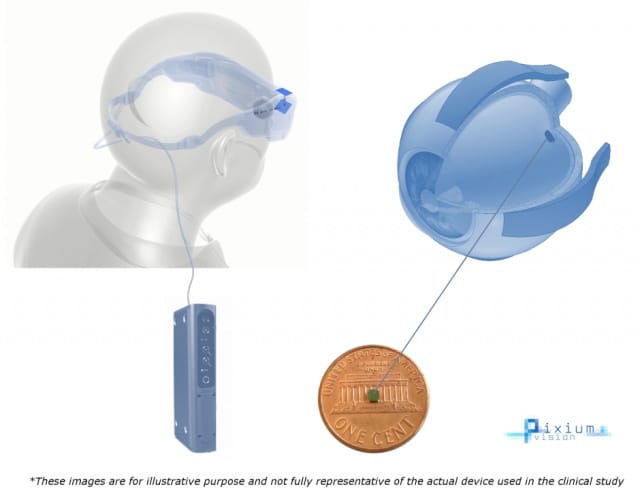
The Prima system, being developed by Paris-based Pixium Vision, was trialled on five patients in France, all of whom had advanced dry Age-related Macular Degeneration (AMD).
The system, which is designed to restore sight in patients blinded by retinal dystrophies such as AMD, consists of a miniaturised, wireless sub-retinal implant, and augmented reality glasses, according to Guillaume Buc, chief technology officer at Pixium Vision.
“We target diseases where the photoreceptors, the part of the retina which receives light and converts it into an initial signal for the brain, may have died,” said Buc. “The idea is to replace the photoreceptors’ function by electrical stimulation, using an implanted prosthesis.”
While none of the patients had any remaining central vision at the start of the trial, after twelve months with the bionic implant most could identify letters, with some able to identify sequences of letters, he said.
The system consists of a 2mm diameter photovoltaic chip, containing 378 electrodes, which is implanted under the retina, where it acts like an array of solar panels.
These panels are powered by a pulsed beam of near infrared light, transmitted by a miniature projector on the glasses. The light also acts as a signal, containing images captured by a mini-camera on the glasses, said Buc.
“The patterned light is projected through the pupil of the eye, and the implant at the back of the retina leverages that signal both as power and a signal,” he said.
“There is a lot of intelligence inside the glasses themselves, which acquire the signal from the miniaturised camera and transform it into a simplified version of the digital scene in front of the patient.”
Age-related macular degeneration is the leading cause of severe vision loss and legal blindness in people over the age of 65 in Europe and the US.
While there are treatments to slow the progression of the wet form of AMD, there is no cure available for the more frequent dry form of the disease.
Patients suffering with this form of retinal dystrophy gradually lose their central vision due to the loss of photoreceptors, said Buc.
“Basically, anything linked to details, such as reading and recognising faces, is the capability that this part of the retina allows, so when these photoreceptors die people dramatically lose their ability to perform daily tasks.”




Nanogenerator consumes CO2 to generate electricity
Whoopee, they've solved how to keep a light on but not a lot else.